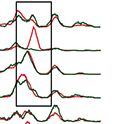Abstract
Changes in gene expression play an important role in evolution, yet the molecular mechanisms underlying regulatory evolution are poorly understood. Here we compare genome-wide binding of the six transcription factors that initiate segmentation along the anterior-posterior axis in embryos of two closely related species: Drosophila melanogaster and Drosophila yakuba. Where we observe binding by a factor in one species, we almost always observe binding by that factor to the orthologous sequence in the other species. Levels of binding, however, vary considerably. The magnitude and direction of the interspecies differences in binding levels of all six factors are strongly correlated, suggesting a role for chromatin or other factor-independent forces in mediating the divergence of transcription factor binding. Nonetheless, factor-specific quantitative variation in binding is common, and we show that it is driven to a large extent by the gain and loss of cognate recognition sequences for the given factor. We find only a weak correlation between binding variation and regulatory function. These data provide the first genome-wide picture of how modest levels of sequence divergence between highly morphologically similar species affect a system of coordinately acting transcription factors during animal development, and highlight the dominant role of quantitative variation in transcription factor binding over short evolutionary distances.
